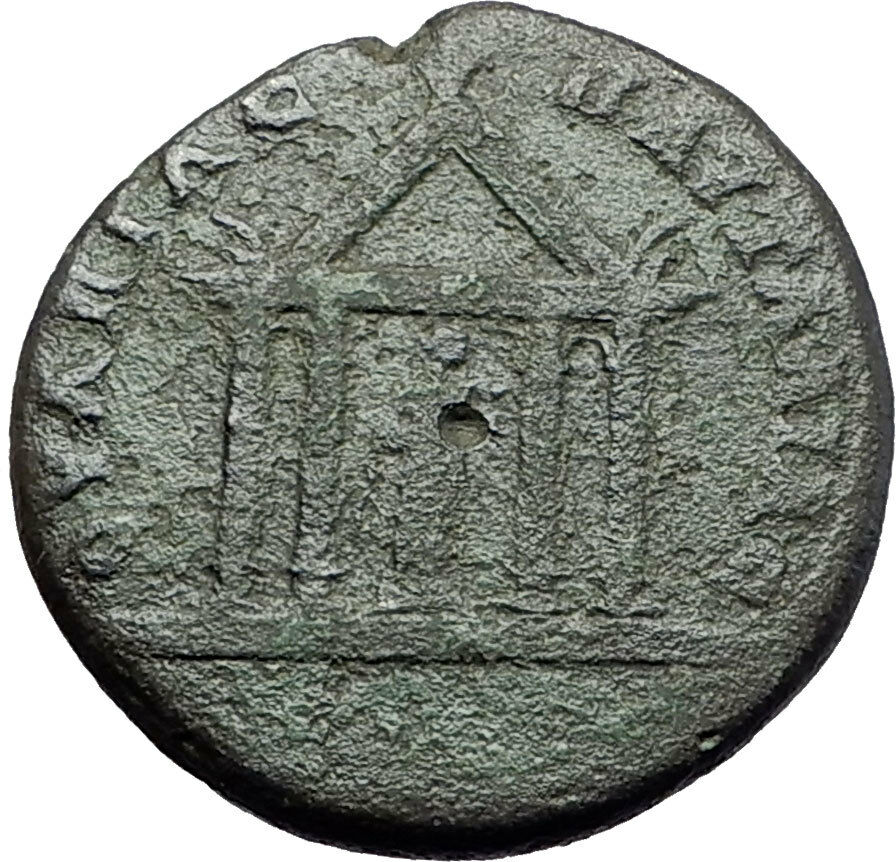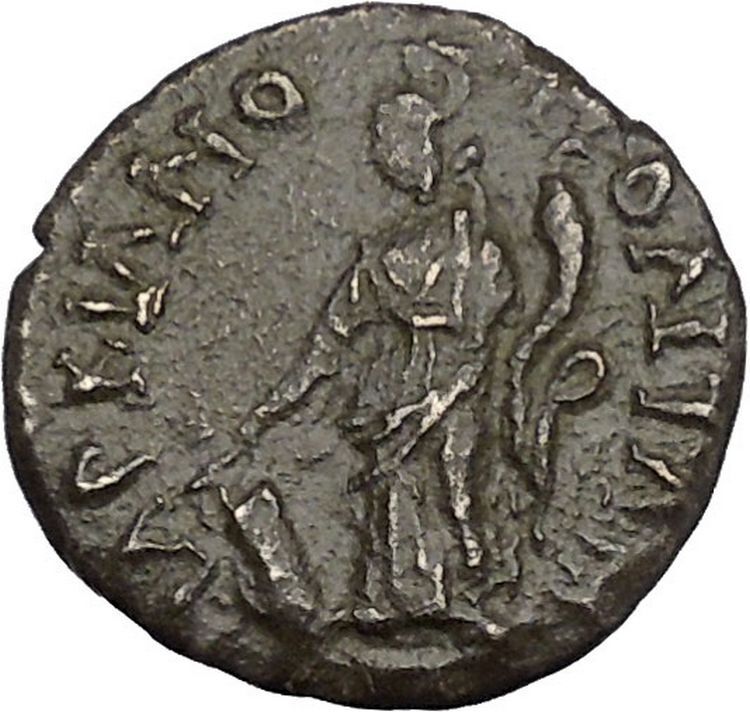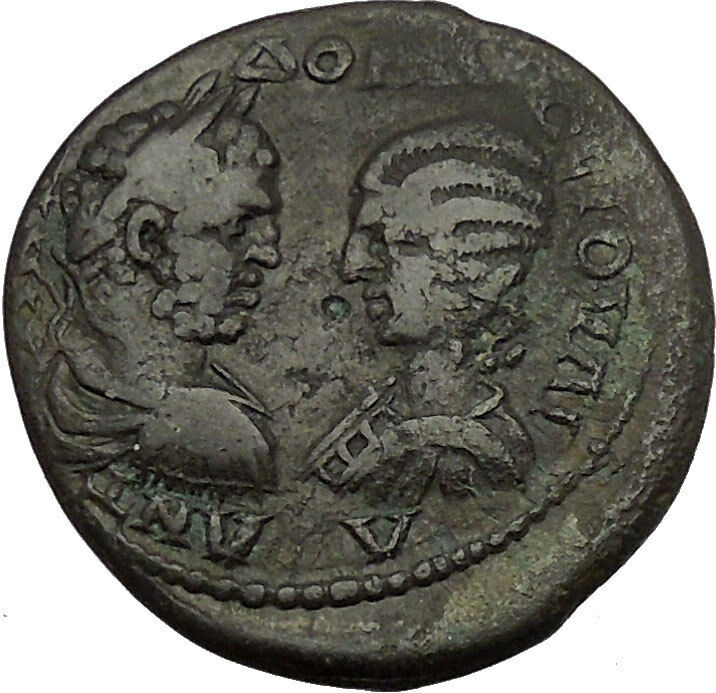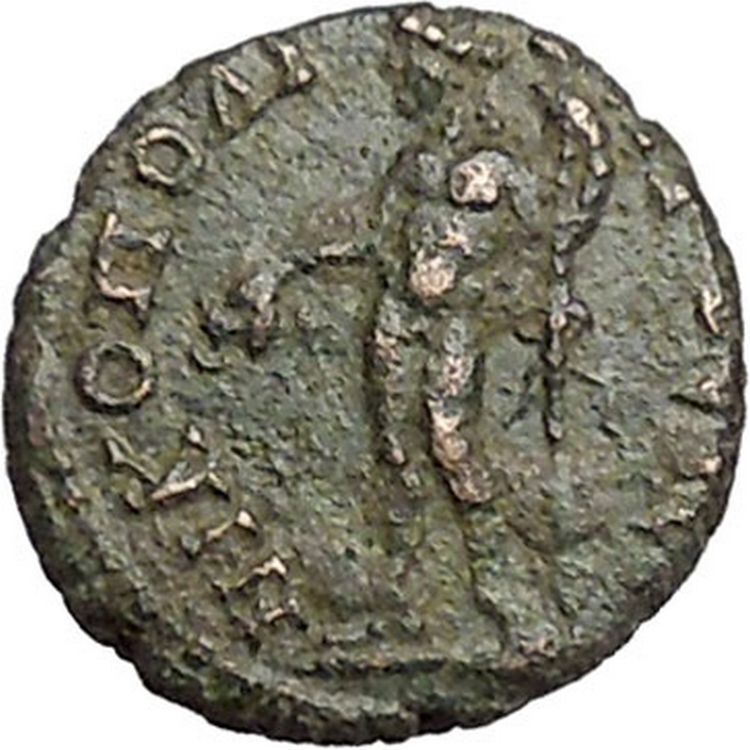|
Sabina – Roman Empress: 117-137 A.D. – wife of Emperor
Hadrian –
Silver Denarius 21mm (5.40 grams) Perinthus, THRACE 128-137 A.D.
Reference: Mouchmov 4453; Varbanov 3764.
SABINA AVGVSTA, diademed and draped bust right.
Demeter standing left, holding grain-ears and sceptre.
Numismatic Note: Green patina
You are bidding on the exact item pictured,
provided with a Certificate of Authenticity and Lifetime Guarantee of
Authenticity.

Vibia
Sabina (83-136/137) was a Roman Empress, wife and second cousin, once
removed, to
Roman
Emperor
Hadrian
. She was the daughter to
Salonina Matidia
(niece of Roman Emperor
Trajan
), and
suffect consul
Lucius Vibius Sabinus
. After her father’s death in 84, Sabina along with her
half-sisters lived with their grandmother, mother and were raised in the
household of Trajan, his wife
Pompeia Plotina
and her stepfather.
She married Hadrian in 100
, at the Roman Empress
Pompeia Plotina
‘s request, for Hadrian to succeed her great uncle, in 117.
Sabina’s mother Matidia (Hadrian’s second cousin) was also fond of Hadrian and
allowed him to marry her daughter.
They had no children and had an unhappy marriage. Sabina was said to have
remarked that she had taken steps to see she never had children by Hadrian
because they would “harm the human race”. It seems that she once
aborted
a
child of theirs. Sabina was strong and independent and her beliefs in marriage
didn’t sit well with the Emperor. Sabina had an affair with
Suetonius
a historian (and Hadrian’s secretary) in the year 119. In 128, she was awarded
the title of
Augusta
. Vibia Sabina died before her husband, some time in
136 or early
137.
//
Namesake
Vibia Aurelia Sabina
(170-died before 217), daughter and youngest child of
Roman Emperor
Marcus Aurelius
and Roman Empress
Faustina the Younger
was a great, great niece to Vibia Sabina. Her name was
bestowed in honor of Sabina and her father.
In
ancient Greek religion
and
myth
, Demeter is the goddess of the
harvest, who presided over
grains
and the
fertility
of the earth. Her cult titles include
Sito (σίτος: wheat) as the giver of food
or corn/grain and
Thesmophoros
( thesmos: divine order,
unwritten law) as a mark of the civilized existence of agricultural society.

Though Demeter is often described simply as the goddess of the harvest, she
presided also over the sanctity of
marriage
, the
sacred law
, and the cycle of
life and death
. She and her daughter
Persephone
were the central figures of the
Eleusinian Mysteries
that predated the
Olympian pantheon
. In the
Linear B
Mycenean Greek
tablets of circa 1400-1200 BC
found at Pylos
, the “two mistresses and the king” may be
related with Demeter, Persephone and
Poseidon
. Her
Roman
equivalent is
Ceres
.
Etymology

Didrachme
from Paros island, struck
at the
Cyclades
and representing Demeter
Demeter’s character as
mother-goddess
is identified in the second
element of her name meter derived from
Proto-Indo-European
mother). In antiquity,
different explanations were already proffered for the first element of her name.
It is possible that Da (Δᾶ) (which
became Attic De is the Doric form of Ge (Γῆ),
“earth”, the old name of the
chthonic
earth-goddess, and that Demeter is
“Mother-Earth”. This root also appears in the
Linear B
inscription E-ne-si-da-o-ne,
“earth-shaker”, as an aspect of the god
Poseidon
. However, the dā element is not
so simply equated with “earth” according to
John Chadwick
.
The element De– may be connected with Deo, a surname of Demeter
probably derived from the Cretan word dea , Ionic zeia
meaning “barley”, so that she is the Corn-Mother and the giver of food
generally. Arcadian cult to Demeter links her to a male deity (Greek:
Paredros), who accompanied the
Great Goddess
and has been interpreted as a
possible substitution for
Poseidon
; Demeter may therefore be related to a
Minoan
Great Goddess
.
An alternative, Proto-Indo-European etymology comes through
Potnia
and
Despoina
; where Des- represents a
derivative of
PIE
*dem (house, dome), and Demeter is
“mother of the house”.
Agricultural deity
According to the Athenian
rhetorician
Isocrates
, Demeter’s greatest gifts to
humankind were agriculture, particularly of cereals, and the Mysteries which
give the initiate higher hopes in this life and the afterlife. These two gifts
were intimately connected in Demeter’s myths and mystery cults. In Homer’s
Odyssey
she is the blond-haired goddess who
separates the chaff from the grain. In Hesiod, prayers to
Zeus-Chthonios (chthonic
Zeus) and Demeter help the crops grow full and strong. Demeter’s emblem is the
poppy, a bright red flower that grows among the barley.
In Hesiod
‘s
Theogony
, Demeter is the daughter of
Cronus
and
Rhea
. At the marriage of
Cadmus
and
Harmonia
, Demeter lured
Iasion
away from the other revelers. They had
intercourse in a
ploughed furrow
in
Crete
, and she gave birth to a son,
Ploutos
. Her daughter by Zeus was
Persephone
, Queen of the Underworld.
Festivals and cults
Main articles:
Eleusinian Mysteries
and
Thesmophoria
Demeter’s two major festivals were
sacred mysteries
. Her
Thesmophoria
festival (11–13 October) was
women-only. Her
Eleusinian mysteries
were open to initiates of
any gender or social class. At the heart of both festivals were myths concerning
Demeter as Mother and
Persephone
as her daughter.
Myths
Demeter and Persephone

Demeter drives her horse-drawn chariot containing her daughter
Persephone-Kore
at Selinunte,
Sicily 6th century BC.
Demeter’s virgin daughter Persephone was abducted to the underworld by
Hades
. Demeter
searched for her
ceaselessly, preoccupied with
her loss and her grief. The seasons halted; living things ceased their growth,
then began to die. Faced with the extinction of all life on earth,
Zeus sent his messenger
Hermes
to the underworld to bring Persephone
back. Hades
agreed to release her, but gave her a
pomegranate. When she ate the pomegranate seeds, she was bound to him for one
third of the year, either the dry Mediterranean summer, when plant life is
threatened by drought, or the autumn and winter. There are several variations on
the basic myth. In the
Homeric hymn
to Demeter,
Hecate
assists in the search and later becomes
Persephone’s underworld attendant. In another, Persephone willingly and secretly
eats the pomegranate seeds, thinking to deceive Hades, but is discovered and
made to stay. In all versions, Persephone’s time in the underworld corresponds
with the unfruitful seasons of the ancient
Greek calendar
, and her return to the
upper world
with springtime. Demeter’s descent
to retrieve Persephone from the underworld is connected to the
Eleusinian Mysteries
.
Demeter and her daughter Persephone
were usually called:
- The goddesses, often distinguished as “the older” and “the
younger” in Eleusis
.
- Demeters, in
Rhodes
and
Sparta
- The thesmophoroi, “the legislators” in the
Thesmophoria
.
- The Great Goddesses, in
Arcadia
.
- The mistresses in
Arcadia
.
In
Mycenaean
Pylos
, Demeter and Persephone were probably
called “queens” (wa-na-ssoi)
The myth of the capture of Persephone seems to be pre-Greek. In the Greek
version Ploutos (πλούτος, wealth) represents the wealth of the corn that was
stored in underground silos or ceramic jars (pithoi). Similar
subterranean pithoi were used in ancient times for funerary practices is
fused with Persephone, the Queen of the underworld. At the beginning of the
autumn, when the corn of the old crop is laid on the fields she ascends and is
reunited with her mother Demeter, for at this time the old crop and the new meet
each other.
According to the personal mythology of
Robert Graves
, Persephone is not only the
younger self of Demeter, she is in turn also one of three guises of the
Triple Goddess
— Kore (the youngest, the
maiden, signifying green young grain), Persephone (in the middle, the nymph,
signifying the ripe grain waiting to be harvested), and Hecate (the eldest of
the three, the crone, the harvested grain), which to a certain extent reduces
the name and role of Demeter to that of group name. Before her abduction, she is
called Kore; and once taken she becomes Persephone (‘she who brings
destruction’).
Demeter at Eleusis

Eleusinian trio
:
Persephone
,
Triptolemos
, and Demeter, on a
marble
bas-relief
from
Eleusis
, 440–430 BC
Demeter’s search for her daughter Persephone took her to the palace of
Celeus
, the King of
Eleusis
in
Attica
. She assumed the form of an old woman,
and asked him for shelter. He took her in, to nurse
Demophon
and
Triptolemus
, his sons by
Metanira
. To reward his kindness, she planned
to make Demophon immortal; she secretly anointed the boy with
ambrosia
and laid him in the flames of the
hearth, to gradually burn away his mortal self. But Metanira walked in, saw her
son in the fire and screamed in fright. Demeter abandoned the attempt. Instead,
she taught Triptolemus the secrets of agriculture, and he in turn taught them to
any who wished to learn them. Thus, humanity learned how to plant, grow and
harvest grain. The myth has several versions; some are linked to figures such as
Eleusis
,
Rarus
and
Trochilus
. The Demophon element may be based on
an earlier folk tale.
Demeter and Poseidon
Demeter and Poseidon
‘s names appear in the earliest
scratched notes in
Linear B
found at
Mycenae
and Mycenaean
Pylos
. E-ne-si-da-o-ne (earth-shaker) for
Poseidon, and Si-to po-ti-ni-ja, who is probably related with Demeter.
In the myths of isolated
Arcadia
in southern Greece,
Despoina
, is daughter of Demeter and
Poseidon
Hippios. These myths seem to be
connected with the first Greek-speaking people who came from the north during
the
Bronze age
. Poseidon represents the river
spirit of the underworld and he appears as a horse as it often happens in
northern-European folklore. He pursues the mare-Demeter and she bears one
daughter who obviously originally had the form or the shape of a mare too.
Demeter and Despoina were closely connected with springs and animals, related to
Poseidon as a God of waters and especially with the mistress of the animals
Artemis
, the goddess of Nymphs.
Demeter as mare-goddess was pursued by Poseidon, and hid from him among the
horses of King
Onkios
, but could not conceal her divinity. In
the form of a stallion, Poseidon caught and covered her. Demeter was furious (erinys)
at Poseidon’s assault; in this furious form, she is known as Demeter Erinys. But
she washed away her anger in the River
Ladon
, becoming Demeter Lousia, the
“bathed Demeter”.[32]
“In her alliance with Poseidon,”
Karl Kerenyi
noted, “she was
Earth
, who bears plants and beasts, and could
therefore assume the shape of an ear of
grain
or a mare.” She bore a daughter
Despoina
(Δέσποινα:
the “Mistress”), whose name should not be uttered outside the Arcadian
Mysteries
, and a horse named
Arion
, with a black mane and tail.
In Arcadia
, Demeter’s mare-form was worshiped into
historical times. Her
xoanon
of Phigaleia shows how the local
cult interpreted her: a Medusa type with a horse’s head with snaky hair, holding
a dove and a dolphin, probably representing her power over air and water.
The second mountain, Mt. Elaios, is about 30 stades from
Phigaleia
, and has a cave sacred to Demeter
Melaine [“Black”]… the Phigalians say, they accounted the cave sacred to
Demeter, and set up a
wooden image
in it. The image was made in
the following fashion: it was seated on a rock, and was like a woman in all
respects save the head. She had the head and hair of a horse, and serpents
and other beasts grew out of her head. Her
chiton
reached right to her feet, and she
held a dolphin in one hand, a dove in the other. Why they made the
xoanon
like this should be clear to any
intelligent man who is versed in tradition. They say they named her Black
because the goddess wore black clothing. However, they cannot remember who
made this xoanon or how it caught fire; but when it was destroyed the
Phigalians gave no new image to the goddess and largely neglected her
festivals and sacrifices, until finally barrenness fell upon the land.
—
Pausanias
, Description of Greece
8.42.1ff.
Titles and functions
Demeter’s epithets
show her many religious functions. She
was the “Corn-Mother” who blesses the harvesters. Some cults interpreted her as
“Mother-Earth”. Demeter may be linked to goddess-cults of
Minoan
Crete
, and embody aspects of a pre-Hellenic
Great Goddess
. Her other epithets include:

Triptolemus
, Demeter and
Persephone
by the Triptolemos-painter,
ca 470 BC,
Louvre
- Aganippe
(“the Mare who destroys
mercifully”, “Night-Mare”)
- Potnia
(“mistress”) in the
Homeric Hymn to Demeter
.
Hera
especially, but also
Artemis
and
Athena
, are addressed as “potnia” as well.
- Despoina
(“mistress of the house”), a Greek
word similar to the
Mycenean
potnia. This title was also
applied to Persephone,
Aphrodite
and
Hecate
.
-
Thesmophoros
(“giver of customs” or even
“legislator”), a role that links her to the even more ancient goddess
Themis
, derived from thesmos, the
unwritten law.[36]
This title was connected with the
Thesmophoria
, a festival of secret
women-only rituals in
Athens
connected with marriage customs.
- Erinys
(“implacable”), with a function
similar with the function of the avenging
Dike
(Justice), goddess of moral justice
based on custom rules who represents the divine retribution,[38]
and the Erinyes
, female ancient
chthonic
deities of vengeance and
implacable agents of retribution.
- Chloe
(“the green shoot”), that invokes her
powers of ever-returning fertility, as does Chthonia.
- Chthonia
(“in the ground”),
chthonic
Demeter in Sparta.
- Anesidora
(“sending up gifts from the
earth”) applied to Demeter in Pausanias 1.31.4, also appears inscribed on an
Attic ceramic a name for
Pandora
on her jar.
- Europa (“broad face or eyes”) at Lebadaea of
Boeotia
. She was the nurse of
Trophonios
to whom a
chthonic
cult and
oracle
was dedicated.
- Kidaria in the mysteries of Pheneos in Arcadia where the priest
put on the mask of Demeter kept in a secret place. It seems that the cult
was connected with the underworld and with an agrarian magic.
Demeter might also be invoked in the guises of:
- Malophoros (“apple-bearer” or “sheep-bearer”, Pausanias 1.44.3)
- Lusia (“bathing”, Pausanias 8.25.8)
- Thermasia (“warmth”, Pausanias 2.34.6)
- Achaea, the name by which she was worshipped at
Athens
by the Gephyraeans who had emigrated
from Boeotia
.[45][46]
Theocritus
, wrote of an earlier role of Demeter
as a poppy goddess:
- For the Greeks Demeter was still a poppy goddess
- Bearing sheaves and poppies in both hands. — Idyll vii.157
In a clay statuette from Gazi (Heraklion Museum, Kereny 1976 fig 15), the
Minoan
poppy
goddess wears the seed capsules, sources
of nourishment and narcosis, in her diadem. “It seems probable that the Great
Mother Goddess
, who bore the names Rhea and
Demeter, brought the poppy with her from her Cretan cult to
Eleusis
, and it is certain that in the Cretan
cult sphere, opium was prepared from poppies” (Kerenyi 1976, p 24).
Cult places
Major
cults
to Demeter are known at
Eleusis
in
Attica
, Hermion (in
Crete
,
Megara
, Celeae,
Lerna
, Aegila,
Munychia
,
Corinth
,
Delos
,
Priene
,
Akragas
,
Iasos
,
Pergamon
,
Selinus
,
Tegea
,
Thoricus
, Dion (in Macedonia)
Lykosoura
,
Mesembria
,
Enna (Sicily), and
Samothrace
.
Demeter of Mysia had a seven-day festival at Pellené in
Arcadia
. Pausanias passed the shrine to Demeter
at Mysia on the road from
Mycenae
to
Argos
but all he could draw out to explain the
archaic name was a myth of an eponymous
Mysius
who venerated Demeter.
Genealogy of the Olympians in Greek mythology
Genealogy
of the
Olympians
in
Greek mythology
|
|
|
|
|
|
|
|
|
|
Uranus
|
|
Gaia
|
|
|
|
|
|
|
|
|
|
|
|
|
|
|
|
|
|
|
|
|
|
|
|
|
|
|
|
|
|
|
|
|
|
|
|
|
|
|
|
|
|
|
|
|
|
|
|
|
|
|
|
|
|
|
|
|
|
|
|
|
|
|
|
|
|
|
|
|
|
|
|
|
|
|
|
|
|
|
|
|
|
|
|
|
|
|
|
|
|
|
|
|
|
|
|
|
|
|
|
|
|
|
|
|
|
|
|
|
|
|
|
|
|
|
|
|
Oceanus
|
|
Hyperion
|
|
Coeus
|
|
Crius
|
|
Iapetus
|
|
Mnemosyne
|
|
|
|
|
| |
|
|
|
|
|
|
|
|
|
|
|
|
|
|
|
|
|
|
|
|
|
|
|
|
|
|
|
|
|
|
|
|
|
|
|
|
|
|
|
|
|
|
|
|
|
|
|
|
|
|
|
|
|
|
|
|
|
|
|
|
|
|
|
|
Cronus
|
|
Rhea
|
|
Tethys
|
|
Theia
|
|
Phoebe
|
|
Themis
|
|
|
|
|
|
|
|
|
|
|
|
|
|
|
|
|
|
|
|
|
|
|
|
|
|
|
|
|
|
|
|
|
|
|
|
|
|
|
|
|
|
|
|
|
|
|
|
|
|
|
|
|
|
|
|
|
|
|
|
|
|
|
|
|
Zeus
|
|
Hera
|
|
Hestia
|
|
Demeter |
|
Hades
|
|
Poseidon
|
|
|
|
|
|
|
|
|
|
|
|
|
|
|
|
|
|
|
|
|
|
|
|
|
|
|
|
|
|
|
|
|
|
|
|
|
|
|
|
|
|
|
|
|
|
|
|
|
|
|
|
|
|
|
|
|
|
|
|
|
|
|
|
|
|
|
|
|
|
|
|
|
Ares
|
|
Hephaestus
|
|
Hebe
|
|
Eileithyia
|
|
Enyo
|
|
Eris
|
|
|
|
| |
|
|
|
|
|
|
|
|
|
|
|
|
|
|
|
|
|
|
|
|
|
|
|
|
|
|
|
|
|
|
|
|
|
|
|
|
|
|
|
|
|
|
|
|
|
|
|
|
|
|
|
|
|
|
|
|
|
|
|
|
Metis
|
|
|
|
Maia
|
|
|
|
|
Leto
|
|
|
|
|
Semele
|
|
|
|
|
|
|
|
|
|
|
|
|
|
|
|
|
|
|
|
|
|
|
|
|
|
|
|
|
|
|
|
|
|
|
|
|
|
|
|
|
|
|
|
|
|
|
|
|
|
|
|
|
|
|
|
|
|
|
|
|
|
Aphrodite
|
|
Athena
|
|
|
Hermes
|
|
Apollo
|
|
Artemis
|
|
Dionysus
|
|
|
| |
|
|
|
|
|
|
|
|
|
|
|
|
|
|
|
|
|
|
|
|
|
|
|
|
|
|
|
|
|
| |
|
Consorts and children
-
-
Persephone
- Poseidon
-
Despoina
-
Arion
- Iasion
- Plutus
-
Philomelus
-
Karmanor
-
Eubuleus
-
Chrysothemis
-
Triptolemus
-
Amphitheus I
- Oceanus
- Dmia
Portrayals
- Demeter was frequently associated with images of the harvest, including
flowers, fruit, and grain. She was also sometimes pictured with her daughter
Persephone.
- The Black Demeter, a sculpture made by
Onatas
.
- Demeter is not generally portrayed with a consort: the exception is
Iasion, the youth of Crete who lay with Demeter in a thrice-ploughed field,
and was sacrificed afterwards – by a jealous, and envious Zeus with a
thunderbolt, Olympian mythography adds, but the Cretan site of the myth is a
sign that the Hellenes knew this was an act of the ancient Demeter.
- Demeter is assigned the zodiac constellation Virgo the Virgin by Marcus
Manilius in his 1st century Roman work Astronomicon. In art, constellation
Virgo holds Spica, a sheaf of wheat in her hand and sits beside
constellation Leo the Lion.
Thrace (demonym Thracian
/
ənθreɪʃⁱˈ/;
Bulgarian
:
Тракия, Trakiya,
Greek
: Θράκη,
Thráki,
Turkish
:
Trakya) is a historical and geographic area in southeast
Europe
. As a geographical concept, Thrace
designates a region bounded by the
Balkan Mountains
on the north,
Rhodope Mountains
and the
Aegean Sea
on the south, and by the
Black Sea
and the
Sea of Marmara
on the east. The areas it
comprises are southeastern
Bulgaria
(Northern
Thrace), northeastern
Greece
(Western
Thrace), and the European part of
Turkey
(Eastern
Thrace). The biggest part of Thrace is part of present-day Bulgaria.
In Turkey, it is also called
Rumelia
. The name comes from the
Thracians
, an ancient
Indo-European
people inhabiting Southeastern
Europe.
The historical boundaries of Thrace have varied. Noteworthy is the fact that,
at an early date, the
ancient Greeks
employed the term “Thrace” to
refer to all of the territory which lay north of
Thessaly
inhabited by the
Thracians
,[1]
a region which “had no definite boundaries” and to which other regions (like
Macedonia
and even
Scythia
) were added.[2]
In one ancient Greek source, the very Earth is divided into “Asia, Libya, Europa
and Thracia”.[2]
As the knowledge of world geography of the Greeks broadened, the term came to be
more restricted in its application: Thrace designated the lands bordered by the
Danube
on the north, by the Euxine Sea (Black
Sea) on the east, by northern
Macedonia
in the south and by the
Illyrian
lands (i.e.
Illyria
) to the west.[2]
This largely coincided with the Thracian
Odrysian kingdom
, whose borders varied in time.
During this time, specifically after the Macedonian conquest, the region’s old
border with Macedonia was shifted from the
Struma River
to the
Mesta River
.[3][4]
This usage lasted until the Roman conquest. Henceforth, (classical) Thrace
referred only to the tract of land largely covering the same extent of space as
the modern geographical region. In its early period, the
Roman province of Thrace
was of this extent,
but after the administrative reforms of the late 3rd century, Thracia’s much
reduced territory became the six small provinces which constituted the
Diocese of Thrace
. The medieval
Byzantine
theme
of
Thrace
contained only what today is
Eastern Thrace
.
The largest cities of Thrace are:
İstanbul
(European side),
Plovdiv
,
Burgas
,
Stara Zagora
,
Haskovo
,
Edirne
,
Çorlu
and
Tekirdag
.
Most of the Bulgarian and Greek population are Christians, while most of the
Turkish inhabitants of Thrace are Muslims.
Thrace in
ancient Greek mythology
Ancient Greek mythology
provides them with a
mythical ancestor, named
Thrax
, son of the war-god
Ares, who was said to reside in Thrace. The Thracians appear in
Homer
‘s
Iliad
as
Trojan allies, led by
Acamas
and
Peiros
. Later in the Iliad,
Rhesus
, another Thracian king, makes an
appearance. Cisseus
, father-in-law to the Trojan elder
Antenor
, is also given as a Thracian king.
Homeric Thrace was vaguely defined, and stretched from the River
Axios
in the west to the
Hellespont
and
Black Sea
in the east. The
Catalogue of Ships
mentions three separate
contingents from Thrace: Thracians led by Acamas and Peiros, from
Aenus
;
Cicones
led by
Euphemus
, from southern Thrace, near
Ismaros
; and from the city of
Sestus
, on the Thracian (northern) side of the
Hellespont, which formed part of the contingent led by
Asius
. Greek mythology is replete with Thracian
kings, including
Diomedes
,
Tereus
,
Lycurgus
,
Phineus
,
Tegyrius
,
Eumolpus
,
Polymnestor
,
Poltys
, and
Oeagrus
(father of
Orpheus
). In addition to the tribe that Homer
calls Thracians, ancient Thrace was home to numerous other tribes, such as the
Edones
,
Bisaltae
,
Cicones
, and
Bistones
.
Thrace is also mentioned in Ovid’s Metamorphoses in the episode of
Philomela
, Procne, and
Tereus
. Tereus, the King of Thrace, lusts after
his sister-in-law, Philomela. He kidnaps her, holds her captive, rapes her, and
cuts out her tongue. Philomela manages to get free, however. She and her sister,
Procne, plot to get revenge, by killing Itys (son of Tereus and Procne) and
serving him to his father for dinner. At the end of the myth, all three turn
into birds—Procne, a swallow; Philomela, a nightingale; and Tereus, a
hoopoe
.
History
Ancient history
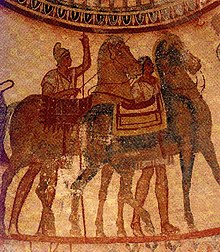
Thracian Tomb of Kazanlak
The indigenous population of Thrace was a people called the
Thracians
, divided into numerous tribal groups.
Thracian troops were known to accompany neighboring ruler
Alexander the Great
when he crossed the
Hellespont
which abuts Thrace, and took on the
Persian Empire
of the day.
The Thracians did not describe themselves as such and Thrace and
Thracians are simply the names given them by the Greeks.[5]
Divided into separate tribes, the Thracians did not manage to form a lasting
political organization until the
Odrysian state
was founded in the 4th century
BC. Like Illyrians
, Thracian tribes of the mountainous
regions fostered a locally ruled warrior tradition, while the tribes based in
the plains were purportedly more peaceable. Recently discovered funeral mounds
in Bulgaria suggest that Thracian kings did rule regions of Thrace with distinct
Thracian national identity.
During this period, a subculture of
celibate
ascetics
called the
Ctistae
lived in Thrace, where they served as
philosophers, priests and prophets.
Medieval history
By the mid 5th century, as the Roman Empire began to crumble, Thracia fell
from the authority of Rome and into the hands of Germanic tribal rulers. With
the fall of Rome, Thracia turned into a battleground territory for the better
part of the next 1,000 years. The eastern successor of the
Roman Empire
in the Balkans, the
Byzantine Empire
, retained control over Thrace
until the 8th century when the northern half of the entire region was
incorporated into the
First Bulgarian Empire
. Byzantium regained
Thrace in the late 10th century and administered it as a
theme
, until the Bulgarians regained
control of the northern half at the end of the 12th century. Throughout the 13th
century and the first half of the 14th century, the region was changing in the
hands of the Bulgarian and the Byzantine Empire(excl. Constantinopole). In 1265
the area suffered a Mongol raid from the
Golden Horde
, led by
Nogai Khan
. In 1352, the
Ottoman
Turks
conducted their first incursion into the
region subduing it completely within a matter of two decades and occupying it
for five centuries.
Modern history
With the
Congress of Berlin
in 1878, Northern Thrace was
incorporated into the semi-autonomous Ottoman province of
Eastern Rumelia
, which united with Bulgaria in
1885. The rest of Thrace was divided among Bulgaria, Greece and Turkey at the
beginning of the 20th century, following the
Balkan Wars
,
World War I
and the
Greco-Turkish War
. Today Thracian is a
strong regional identity in Greece, Turkey, Bulgaria and other neighbouring
countries.
Famous Thracians and people from Thrace
- A number of
Roman emperors
Thraco-Roman backgrounds (Maximinus
Thrax,
Licinius
,
Galerius
,
Aureolus
,
Leo the Thracian
, etc.). These emperors
were elevated via a military career, from the condition of common soldiers
in one of the
Roman legions
to the foremost positions of
political power
.
|












